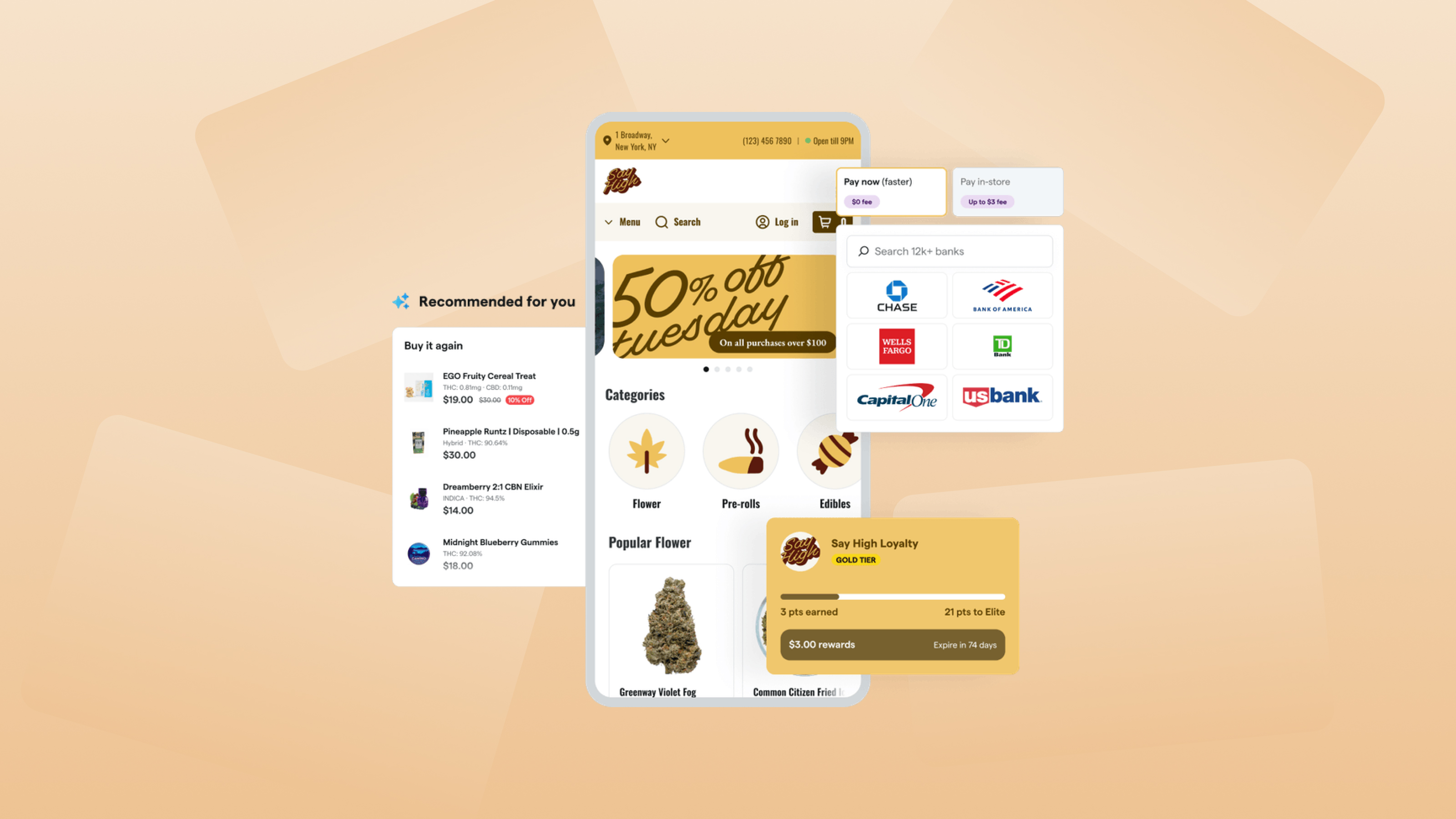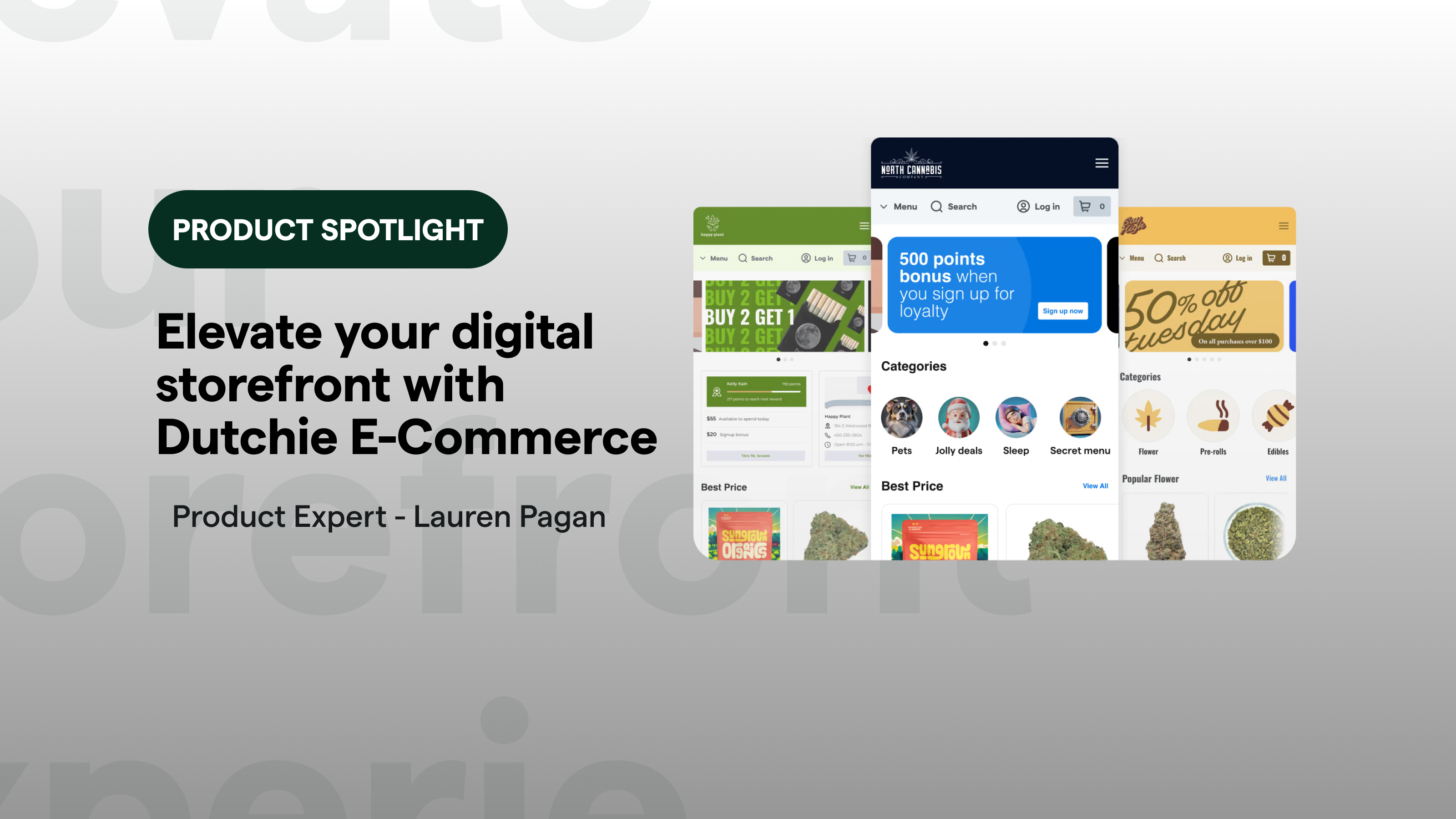
Using order types to increase your dispensary’s sales
Dispensaries are always looking for ways to reduce friction during the checkout experience, so they can convert more customers to buyers. One of the best ways to do this is by providing shoppers with more fulfillment options when ordering products for pickup and delivery. Dispensaries that use Dutchie’s ASAP & Scheduled Orders together can see a 7% increase in total transaction volume. Retailers can customize the order types offered to their customers to best fit their business needs and operations while increasing conversions.
What are order types?
Cannabis retail shops have the ability to offer up to 5 different ordering types for their customers to choose from:
- Kiosk
- Pickup
- Curbside
- Drive-thru
- Delivery
Kiosk and pickup order types both take place as physical, in-store transactions. Curbside and drive-thru work well for speedy purchases with minimal contact. Delivery is the most hands-off for the customer, but it is also the most hands-on for your dispensary staff or delivery driver. As a store owner, you have to take safety into account and the time-consuming legal paperwork that accompanies delivery. It may very well be worth the trouble, though. As DoorDash has shown the world before and during the pandemic, most modern shoppers can’t resist the convenience that a delivery option offers them. Although most of these options are not cannabis-specific, they have proved that the delivery of goods is on the rise with no signs of slowing down.
In-store ordering
An in-store kiosk is great for those who know what they want and don’t necessarily need to wait for a budtender to guide them through the various products. These kiosks are a time saver for both the dispensary business and the customer. This process, mentioned in our post Using Retail Tech to Streamline the Dispensary Experience, shortens the customer’s wait time and grants your budtenders a moment of reprieve.
There is also a way to leverage the kiosk to self-teach your customers about products when the store volume is simply too high for the staff. Like the Apple retail model discussed in our retail technology post, consider using a mobile kiosk to provide a more consultative shopping experience if you’re showing customers around various products. While most states and provinces have strict rules about customers touching the product, they can see protected and interactive displays, try out samples of unmedicated products, and read digital descriptions. According to Digital Commerce 360, the self-serve model is a growing trend in many retail environments and will likely continue.
Another popular order type is the simple in-store pickup technique. This method allows a customer to spend less time in the store if they are in a time crunch, and they can conveniently place the order online from their own device. This is a popular order type for food pickup, and it works well for cannabis products too. It can also help the customer snag a limited item before it quickly sells out.
This typically works when a dedicated station is set up to house Dutchie’s Ordering Terminal. The Ordering Terminal, provided with your software, shows incoming orders in real-time and spits out a receipt that the budtender can use to fill and hold the order. See the budtender station example below.

When the budtender has pre-filled the order, they can set it aside with the Dutchie receipt stapled to it, so it is ready to quickly ring up when the customer arrives. Supplying Dutchie Ecommerce customers with a separate ordering station can also help organize various lines based on their speed. On busier times and days, dispensaries can create maximum Order Limits and times slots within their Dutchie Ecommerce software. They can also space out order fulfillment by utilizing the ASAP and Scheduled Orders options.
Curbside and drive-thru
Curbside service is another option your dispensary could offer with little to no additional equipment necessary. Like a drive-in restaurant, curbside is similar to in-store order fulfillment, except that your staff brings the order outside to a customer’s vehicle when they arrive. Whether their Ecommerce Curbside order is on the fly, or at a certain time, customers can notify you when they’re outside and provide details that make them easy to find. Additionally, dispensaries can control the flow of parking lot traffic with maximum Order Limits, time slots, and even a designated curbside parking spot.
In this nascent market, drive-thru windows for cannabis purchases are a new and inventive idea. Most dispensaries are not built with one, but adding it or finding a building that would suit this order method may create a new and lucrative revenue stream. A drive-thru scenario is permitted in certain medical states according to The Future Is Now: 8 States Offer Legal Cannabis Drive-Thrus from Cannabis MD. Check for recent updates in either medical or recreational states to confirm if this is an option in your area.
Much like fast-food, you could run this operation with minimal staff (2-3 workers). One person could be designated to take the order and check IDs at the window and accept the payment in advance. The second person could fulfill, confirm, and hand off the order to the customer through a second window. Drive-thru dispensaries would allow for a high volume of orders faster than some of the other options. Drive-thrus create a colorful idea for businesses with limited staffing—try offering a Drive-Thru-specific menu to make ordering and fulfillment quicker and easier. Drive-thrus are also incredibly convenient for medical patients to get their medicine without exerting too much physical energy.
Delivery
The perks of delivery speak for themself. Customers want to feel comfortable when making a cannabis purchase, so what could be better than receiving cannabis in the comfort of their own home? This ordering type works for the parent at home that can’t pick up their “pick-me-up” with kids under 21 in tow. It is also a benefit for those with limited transportation. Whatever the reason may be, delivery is always a highly valued order type.
POS software often integrates with portable hardware that enables delivery, but that may not translate to ringing the actual transaction at a customer’s residence. A dispensary should look for a POS system that makes integrating with METRC, or their state’s Cannabis Tracking System (CTS), as smooth as possible because that’s where all delivery manifests have to be documented. If your POS does that, the delivery process will go much smoother. Dutchie POS works well with last-mile tracking and state inventory tracking.
With Dutchie’s Delivery, you as a business owner are in full control of the parameters involved (with state regulations in mind). You can easily customize the operating times, limit the volume of orders, create an order cost minimum or fee, and more. In certain markets, you can even increase your delivery range and efficiency by offering mobile retail. Known as the “Ice Cream Truck Model,” mobile retail means getting permission in your state to travel with excess products and continue the delivery process for new orders on the go. So long as any order discrepancies are reported in the delivery manifest, and you are following your state’s compliance requirements, there’s no reason cannabis delivery cannot be timed more efficiently.
The bottom line
All five of these ordering types can be scaled to fit your business needs. Choosing which of the five (or all) that you can offer will influence your order scheduling and your in-store staff scheduling. Use this information to widen your approach to cannabis sales and likely increase revenue.
Ready to learn more? Get in touch with our sales team to schedule a demo of Dutchie Ecommerce’s custom order options and more.










































